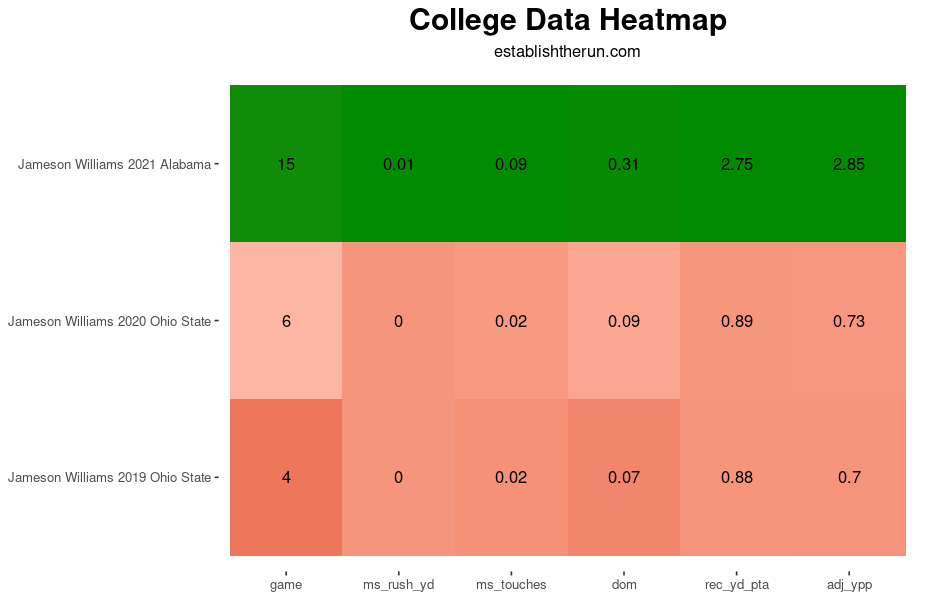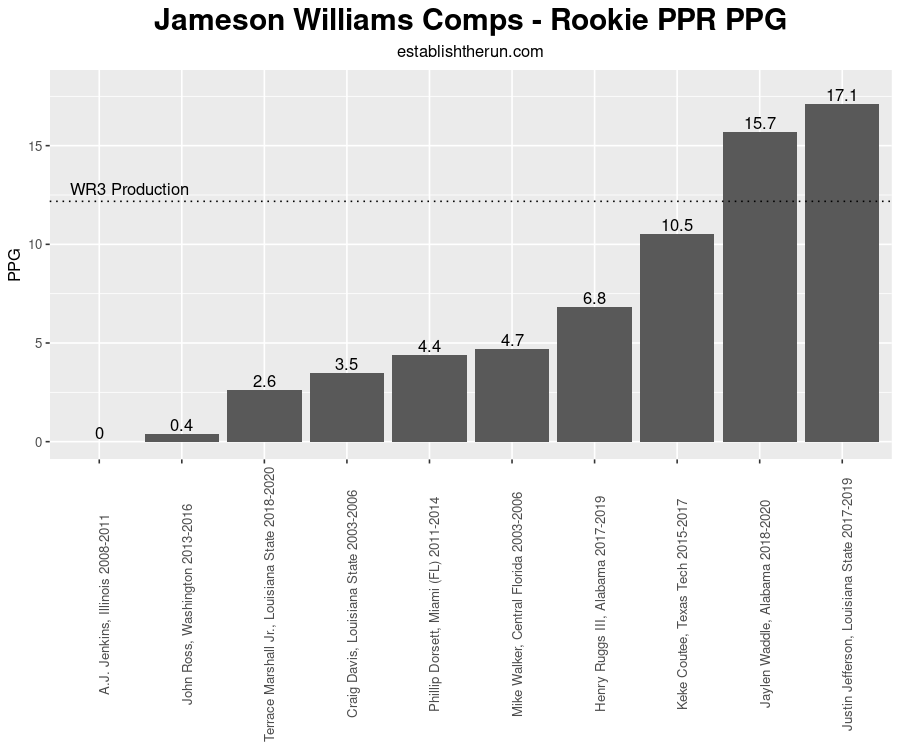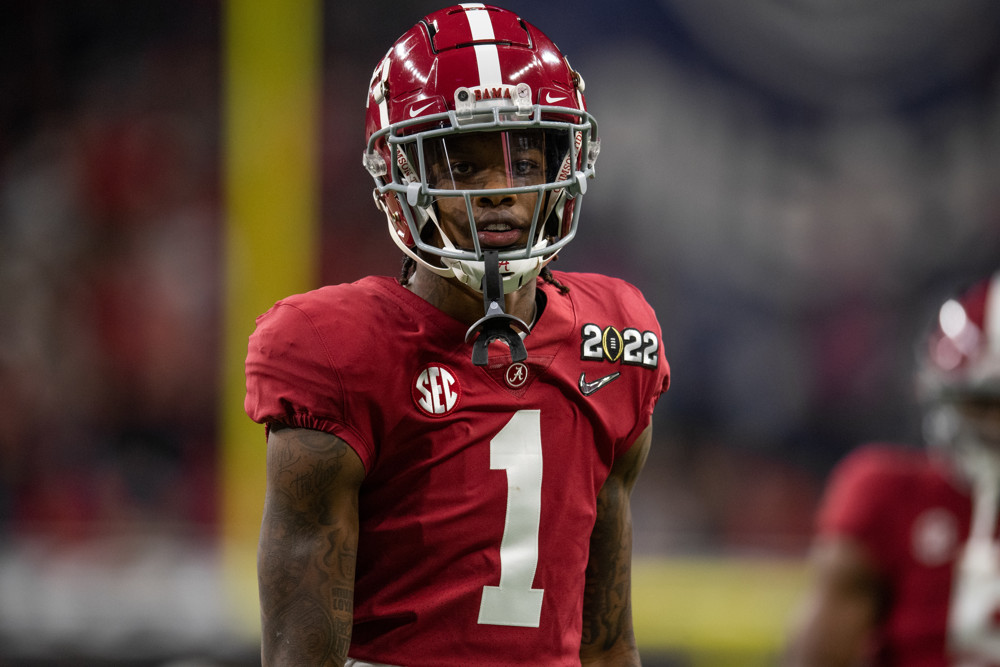Dynasty Outlook
March 6
Williams came in 10 pounds underweight, but that was to be expected coming off of an ACL tear. We will hold off on updating anything with him until he has had some more time to lift and rehab. Alabama’s Pro Day is March 30, and we should get a more accurate weigh-in then.
Feb. 20
Williams is someone we like as a pick in the middle of the first round for rookie drafts, and is WR28 in our overall dynasty ranks. The speed WRs don’t always pop for fantasy, and are typically the kinds of players most likely to be tagged “better real-life” players. That is something to keep in mind when drafting Williams, but it isn’t mutually exclusive to his success. With that said, his play style and competition level in college make Williams someone with a wide range of outcomes, though it is worth noting he has very few elite fantasy players within that range. He has a slender build, but won’t turn 21 until March. There is definitely room for him to fill out into his body and tap into some higher ceiling outcomes.
Profile Summary
Speed. That may not be all that Alabama wide receiver Jameson Williams brings to the table, but it is the trait that is most likely to land him in the first round of the NFL Draft despite tearing his ACL in the National Championship Game. All of the scouts note how fast he is, and his statistical comps are almost exclusively some of the fastest WRs we’ve seen enter the league. It is critical to note this elite trait because Williams’ production profile lacks due to his early years at Ohio State.
Because of his ACL tear, we won’t get to see Williams run at the NFL Combine, but we can do a good job approximating how well he would have run had he been able to. Williams has a personal-best 10.54 in the 100-meter dash, which is extremely close to Henry Ruggs (10.53). Ruggs ran a 4.26 at the Combine. In this video from a Rivals camp in 2018, we can see Williams win a race against another player in the 40. That player is Georgia cornerback Kelee Ringo, who was laser-timed at 4.35 in 2019. It is fair to assume that Williams is somewhere in the range of Ruggs and Ringo.
Vitals
Age (as of 12/31/21) — 20.8
Experience — 3 years
Height — 73.5 inches
Weight — 179 pounds
Hand Size — 9.25 inches
Arm Length — 32.125 inches
Wingspan — 75.875 inches
By the Numbers

Williams has only one season of meaningful production after transferring to Alabama from Ohio State. As a Buckeye, he was mostly relegated to special teams work as a freshman, then was a distant third in receiving to both Chris Olave and Garrett Wilson as a true sophomore. That he went to Alabama and immediately became their top weapon speaks more to the surrounding talent and coaching staff at Ohio State than a lack of talent for Williams.
His season at Alabama qualified as a true breakout, and he was remarkably efficient for the Crimson Tide, averaging 19.9 yards per reception on 79 catches. Williams compiled 1,572 receiving yards, teammate John Metchie had 1,142, and no other Alabama target had more than 410. Williams was absolutely dominant with 15 TDs, and tacked on another two as a kick returner. His statistics likely would look even better without the injury.
What the Scouts are Saying
The Athletic’s Dane Brugler made note of Williams’ elite speed in his latest big board.
If not for his recent ACL injury, Williams would be about 10 spots higher on this list. Born into a track family, he has elite speed in his routes and with the ball in his hands. And he is more than just speed, tracking the ball well downfield and making easy adjustments on the football. In a downfield passing offense in the NFL, Williams has a chance to be special — as long as his knee makes a full recovery.
Daniel Jeremiah was effusive in his praise of Williams, while noting some issues with his hands.
Williams is a tall, lean, and explosive wideout. Everything he does on the field is sudden and fast. He explodes off the line in his release; just when you think he’s reached top speed, he taps into a gear that very few possess. He turns quick-hitters into long touchdowns and climbs on top of coverage in every game viewed. He is at his best on runaway routes, but flashes the ability to efficiently get in and out of breaks. His hands are inconsistent, though. He lets too many balls get into his body and that results in drops. After the catch, Williams destroys pursuit angles with his speed. His production as a gunner on the punt team speaks to his competitiveness. He suffered a torn ACL in the College Football Playoff National Championship, but once healthy, Williams could emerge as one of the premier deep threats in the NFL.
Lance Zierlein noted some more of Williams’ limitations, but is consistent with the other scouts on praising his speed. Zierlein comped Williams to Will Fuller.
Linear route-runner with electric long speed to impact a game as a home-run hitter or decoy drawing defenders away from other elements of the offense. Williams ruins man coverage but faces some limitations. He has issues getting off press cleanly and might require some scheming to help get off the mark cleanly against certain corners. Catch toughness can be inconsistent when contested or in heavily trafficked areas. He has all the juice to find consistent separation on vertical, over, and post/corner routes and could see monstrous production if paired with a high-end talent at quarterback. The ACL tear could play a role in determining his ultimate draft destination, but it’s unlikely to change his game.
Draft Projection
Williams currently has an expected draft position of 22.6 on Grinding the Mocks, which sources mock drafts around the interwebs. Mock Draft Database is a similar service that has Williams 20th overall. He is 20th on Brugler’s Big Board, and 30th on Jeremiah’s. As of now, it appears Williams is destined to be drafted somewhere in the second half of the first round.
Comparable Players
I use Principal Component Analysis to evaluate WR prospects. In simplest terms, this kind of analysis looks at relevant data points to find the closest comparable WRs in past drafts. I prefer this to a model output — which yields only a single result — as it can display the possible range of outcomes for a prospect.
Note that the analysis itself isn’t telling us how good a player is; it is simply returning the most similar players. It is then up to us to layer in context and past results to see how good we think this player may be.

There is a wide range of outcomes on Williams, whose top comparable players are studs such as Justin Jefferson and Jaylen Waddle, while at the backend we see speedsters who ultimately couldn’t produce like John Ross and Phillip Dorsett. Again, it bears noting that there are *no* athletic measurables used to build these comps, and yet we still see the consistent speed element noted by the scouts.
The lack of production and transfer early in Williams’ career makes his comps less tenable than for other prospects, as it may distort the picture of who he really is. Fuller, for example, does not make this list of comparable players because he broke out as a sophomore (if we restrict the list to only WRs who played 3+ seasons, Fuller would be on it).
With that said, it is reassuring to see other players from the same program in Waddle and Ruggs, who struggled to see production early in their careers while playing alongside other first-round talents. When considering that context, it is easier to lean optimistic on Williams than pessimistic. Players such as Ross and Dorsett did not face nearly the same level of competition in their respective programs.


